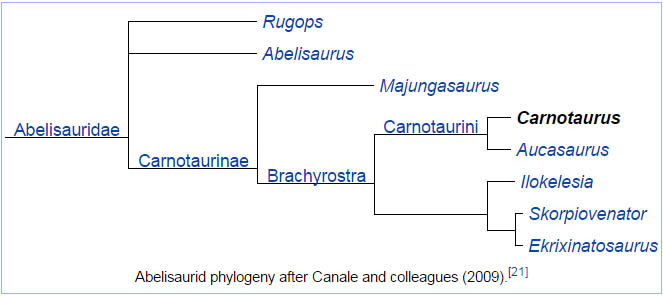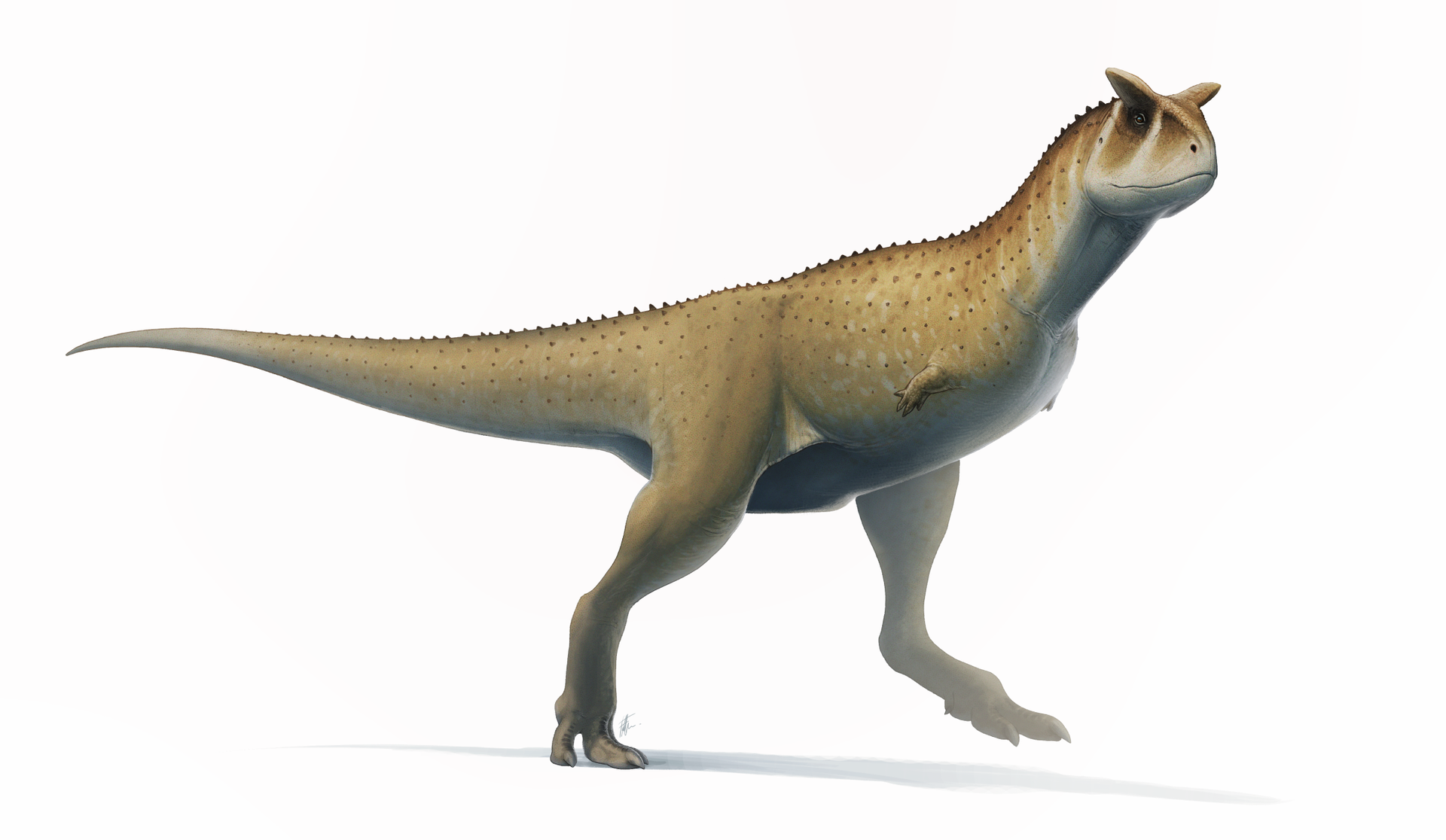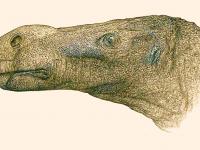Carnotaurus
Carnotaurus is a genus of large theropod dinosaur that lived in South America during the Late Cretaceous period, between about 72 and 69.9 million years ago. The only species is Carnotaurus sastrei. Known from a single well-preserved skeleton, it is one of the best-understood theropods from the Southern Hemisphere. The skeleton, found in 1984, was uncovered in the Chubut Province of Argentina from rocks of the La Colonia Formation. Derived from the Latin carno [carnis] (“flesh”) and taurus (“bull”), the name Carnotaurus means “meat-eating bull”, an allusion to the animal’s bull-like horns. Carnotaurus is a derived member of the Abelisauridae, a group of large theropods that occupied the large predatorial niche in the southern Landmasses of Gondwana during the late Cretaceous. The phylogenetic relations of Carnotaurus are uncertain; it might have been closer to either Majungasaurus or Aucasaurus.
Carnotaurus was a lightly built, bipedal predator, measuring 8 to 9 m (26.2 to 29.5 ft) in length and weighing at least 1.35 metric tons (1.33 long tons; 1.49 short tons). As a theropod, Carnotaurus was highly specialized and distinctive. It had thick horns above the eyes, a feature unseen in all other carnivorous dinosaurs, and a very deep skull sitting on a muscular neck. Carnotaurus was further characterized by small, vestigial forelimbs and long and slender hindlimbs. The skeleton is preserved with extensive skin impressions, showing a mosaic of small, non-overlapping scales approximately 5 mm in diameter. The mosaic was interrupted by large bumps that lined the sides of the animal, and there are no hints of feathers.
The distinctive horns and the muscular neck may have been used in fighting conspecifics. According to separate studies, rivaling individuals may have combated each other with quick head blows, by slow pushes with the upper sides of their skulls, or by ramming each other head-on, using their horns as shock absorbers. The feeding habits of Carnotaurus remain unclear: some studies suggest the animal was able to hunt down very large prey such as sauropods, while other studies find it preyed mainly on relatively small animals. Carnotaurus was well adapted for running and was possibly one of the fastest large theropods.
Description
Carnotaurus was a large but lightly built predator. The only known individual was about 8–9 m (26.2–29.5 ft) in length, making Carnotaurus one of the largest abelisaurids. While Ekrixinatosaurus and possibly Abelisaurus, highly incomplete, would have been similar or larger in size, a 2016 study found that only Pycnonemosaurus, at 8.9 m (29.2 ft), was longer than Carnotaurus, which was estimated at 7.8 m (25.6 ft). Its mass is estimated to have been 1,350 kg (1.33 long tons; 1.49 short tons) 1,500 kg (1.5 long tons; 1.7 short tons) and 2,100 kg (2.1 long tons; 2.3 short tons) in separate studies that used different estimation methods. Carnotaurus was a highly specialized theropod, as seen especially in characteristics of the skull, the vertebrae and the forelimbs. The pelvis and hindlimbs, on the other hand, remained relatively conservative, resembling those of the more basal Ceratosaurus. Both the pelvis and hindlimb bones were long and slender. The left thigh bone of the individual measures 103 cm in length, but shows an average diameter of only 11 cm.
Classification
Carnotaurus is one of the best-understood genera of the Abelisauridae, a family of large theropods restricted to the ancient southern supercontinent Gondwana. Abelisaurids were the dominant predators in the Late Cretaceous of Gondwana, replacing the carcharodontosaurids and occupying the ecological niche filled by the tyrannosaurids in the northern continents. Several notable traits that evolved within this family, including shortening of the skull and arms as well as peculiarities in the cervical and caudal vertebrae, were more pronounced in Carnotaurus than in any other abelisaurid.
Though relationships within the Abelisauridae are debated, Carnotaurus is consistently shown to be one of the most derived members of the family by cladistical analyses. Its nearest relative might have been either Aucasaurus or Majungasaurus; this ambiguity is largely due to the incompleteness of the Aucasaurus skull material. A recent review suggests that Carnotauruswas not closely related with either Aucasaurus or Majungasaurus, and instead proposed Ilokelesia as its sister taxon.
Carnotaurus is eponymous for two subgroups of the Abelisauridae: the Carnotaurinae and the Carnotaurini. Paleontologists do not universally accept these groups. The Carnotaurinae was defined to include all derived abelisaurids with the exclusion of Abelisaurus, which is considered a basal member in most studies. However, a 2008 review suggested that Abelisaurus was a derived abelisaurid instead. Carnotaurini was proposed to name the clade formed by Carnotaurus and Aucasaurus; only those paleontologists who consider Aucasaurus as the nearest relative of Carnotaurus use this group.

Discovery
The only skeleton (holotype MACN-CH 894) was unearthed in 1984 by an expedition led by Argentinian paleontologist José Bonaparte. This expedition also recovered the peculiar spiny sauropod Amargasaurus. It was the eighth expedition within the project named “Jurassic and Cretaceous Terrestrial Vertebrates of South America”, which started in 1976 and which was sponsored by the National Geographic Society. The skeleton is well-preserved and articulated (still connected together), with only the posterior two thirds of the tail, much of the lower leg, and the hind feet being destroyed by weathering. During fossilization, the skull and especially the muzzle were crushed laterally, while the premaxilla were pushed upwards onto the nasal bones. As a result, the upward curvature of the upper jaw is artificially exaggerated in the holotype. The skeleton belonged to an adult individual, as indicated by the fused sutures in the brain case. It was found lying on its right side, showing a typical death pose with the neck bent back over the torso. Unusually, it is preserved with extensive skin impressions. In view of the significance of these impressions, a second expedition was started to reinvestigate the original excavation site, leading to the recovery of several additional skin patches.
The skeleton was collected on a farm named “Pocho Sastre” near Bajada Moreno in the Telsen Department of Chubut Province, Argentina. Because it was embedded in a large hematite concretion, a very hard kind of rock, preparation was complicated and progressed slowly. In 1985, Bonaparte published a note presenting Carnotaurus sastrei as a new genus and species and briefly describing the skull and lower jaw. The generic name (Latin carno [carnis] – “flesh” and taurus – “bull”) refers to the bull-like horns, while the specific name sastrei honors Angel Sastre, the owner of the ranch where the skeleton was found. A comprehensive description of the whole skeleton followed in 1990. After Abelisaurus, Carnotaurus was the second member of the family Abelisauridae that was discovered. For years, it was by far the best-understood member of its family, and also the best-understood theropod from the Southern Hemisphere. It was not until the 21st century that similar well-preserved abelisaurids were described, including Aucasaurus, Majungasaurus and Skorpiovenator, allowing scientists to re-evaluate certain aspects of the anatomy of Carnotaurus. The holotype skeleton is displayed in the Argentine Museum of Natural Sciences, Bernardino Rivadavia; replicas can be seen in this and other museums around the world. Sculptors Stephen and Sylvia Czerkas manufactured a life-sized sculpture of Carnotaurus that is now on display in the Natural History Museum of Los Angeles County. This sculpture, ordered by the museum during the mid-1980s, is probably the first life restoration of a theropod showing accurate skin.
Source: https://en.wikipedia.org











